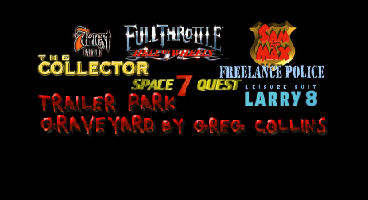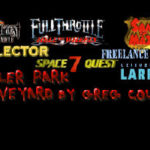
Trailer Park Graveyard
Five big ones that got away, and signaled the end of an era in adventure gaming
Before Roberta and Ken Williams got the idea that, hey, wouldn’t it be great to have a character onscreen walking around interacting with things, adventure games were restricted to text only, or text with the occasional static image. The first King’s Quest in the mid-Eighties changed all that and helped usher in the golden era of graphic adventures.
In the early Nineties game executives laughed at the notion that the brand-new CD-ROM drives could be used for gaming. At the time they had pitiful data transfer rates, until Graeme Devine at Trilobyte wrote a program that maximized the CD’s graphics output. The 7th Guest, the first blockbuster CD-ROM interactive adventure was another industry game changer.
Biggest of all, LucasArts, the game division of George Lucas’s Star Wars mega-enterprise, was releasing classic after classic during the decade. Their SCUMM game engine, beginning with Maniac Mansion, freed adventure gamers from the text parser, with a limited vocabulary of combinable actions listed at the bottom of the screen. Subsequent classics like Loom, Fate of Atlantis, Curse of Monkey Island and Grim Fandango would take the adventure genre as close to “art” as they’d ever get.
If you were an adventure gamer in the late Nineties, you were a happy camper, as new games would be regularly released with ever better graphics and sound. And then, out of the blue, just as it did for the Triceratops and the Brontosaurus, came the wholly unexpected Global Extinction Event. In a few short years, the big gaming behemoths were either out of business or lumbering on to other gaming genres. Sierra was sold off into oblivion, Trilobyte disintegrated, and Lucasarts glommed onto the First Person Shooter and other action games that had become the next big thing.
Of all the big adventure game companies, only Cyan, the creators of Myst and Riven, tried to hold on. But at the beginning of the third millennium even they were lured off into presumably greener gaming pastures. While they farmed out the next couple of Myst sequels to other production houses, Cyan itself turned to Uru and the “online community” concept. A nice try, but a bust. Facebook claimed the social networking glory in the previous decade, not Myst Online. Socializers are interested in their world, not yours.
Luckily, the adventure game managed to survive. Newer, nimbler, humbler companies rushed in to fill the void left by the departing dinosaurs. Advances in computers, software and networking even allowed talented individuals to create commercially viable games single-handed. Still, one was left pondering what might have been. What would adventure games have been like the past dozen years or so if the big commercial houses had kept up production and innovation at their Nineties’ pace? What would an adventure game be like if it were produced with the same multimillion dollar budget of a Halo or Star Wars 1313? What would the Myst-Riven franchise now be like if the Miller brothers hadn’t broken up, if Cyan had put its energies into puzzles instead of “friending”?
Of course, we’ll never know. The one small window we have is the few trailers made just before The End. I admit that I still watch them wistfully from time to time, wishing they and their siblings could have made it to daylight. I have had these five trailers in assorted file formats for years. It is only YouTube that now permits me to share them with you, as I recently realized all five had been uploaded by others. How long these links will remain active, I don’t know. Catch them now before they too one day are gone for good.
Sam & Max: Freelance Police
Yes, I know, there have been three full “seasons” of new Sam and Max adventures from Telltale Games. This trailer, however, is of a planned LucasArts sequel in 3D. How the series would have evolved differently in LucasArts’s hands as opposed to Telltale’s is impossible to tell. As good as the Telltale games have been, however, none has come close to the brilliant LucasArts original. Also, the Telltale games have, for the most part, been dumbed down in gameplay. Very possibly Star Wars and Co. would have gone the same route.
You will notice that many of these “upcoming” games are in 3D. That’s because 3D was the big gaming concept circa 2000. We did indeed get a Monkey Island sequel that year in 3D, Escape From Monkey Island. That game, probably more than anything else, shows how commercial adventures would have looked and played at the turn of the millennium. The fourth installment in the classic series, it was not considered a success and in all likelihood helped convince Lucas to pull the plug on the Sam & Max and Full Throttle sequels and move full-steam into actioners.
Full Throttle 2
The original Full Throttle is not among my favorite adventures. It’s too short and has too much “action” for my taste. But such was the respect that adventure gamers held for LucasArts during this era that any new release was awaited breathlessly. This sequel too was slated for the 3D treatment. I suspect it was a game close to George Lucas’s heart, as is anything redolent of the Greaser Fifties. Motorcycles and gang warfare — it must have killed George to see this one go down in flames. No doubt FT2 would have had an even more combustible adventure-action mixture. It even might have kept the big commercial adventure alive for a while longer.
Space Quest 7
Another game being constructed in 3D, Space Quest 7 appears, judging by this teaser, to have lost none of its famed insouciance. Space Quest 6 had been a radical technical advance from the first five games and this new one looks like it was going to be quite another big change.
I have written elsewhere about the strange connection independent game makers have for Sierra’s irreverent and wacky Space Quest series. The many tribute Space Quest games are quite well written and I am happy to have them, but only a big production company like Sierra could have poured in the buckazoids to produce the kind of game that this trailer hints at.
Leisure Suit Larry 8
I am heartened that there are plans afoot to return Larry Laffer to commercial gamedom. When I interviewed Al Lowe a few years back he sounded completely disgruntled and done with the Sierra series that made him famous. Now, with the new Kickstarter project, he seems rejuvenated. I hope that the new Leisure Suit Larry remakes make it, but it’s not likely to have the production oomph that Sierra could have provided. This very brief “test” is, Al assured me, all that remains of LSL8. At the time, he and Sierra were breaking up and he told me he was not about to start the grueling work of creating a new game “on spec.”
The Collector (The 7th Guest III)
This is the one that most breaks my heart when I rewatch it. Trilobyte was never the most stable of operations. They only barely stayed afloat long enough to get out The 7th Guest and its sequel The 11th Hour (along with a few other, less notable titles). But the puzzle-adventure is my favorite subspecies of adventure game and so few of them were ever made by anybody. This is the longest and most tempting of the trailers. It gives a good sense of what the game would have looked and even played like, as opposed to just being a promotional ad.
It’s the only one I still hold out some faint hope for. Trilobyte has resurfaced on the web and they’re making noises about upcoming games, including The 7th Guest III. Whether that is the same game as The Collector, I don’t know. But I’d be quite interested either way. There has also long been a promising fan-made “7th Guest 3” in the works called The 13th Doll. But this has been coming down the pike so long I’ve largely given up hope of ever seeing a finished game.
There have been other canceled adventure games, of course. We’ve also witnessed a couple of miraculous releases. Jane Jensen, like Al Lowe another great Sierra alum, somehow managed to hang tough and get the long anticipated Gray Matter out. I personally was ecstatic when Gobliiins 4 made it to market. Of course, even the big commercial houses would have had to do more than produce a slate of 3D sequels to keep the big-budget adventure alive into the 2000s.
More so than any other genre, the adventure game depends on good writing. This is why even a humble production can at times make for a great game. Adventure game fans are fortunate in this regard, since in a sense we don’t have to depend on the big commercial conglomerates to provide us with good product.
Still, the Golden Age was a fine adventure while it lasted.

Leave a Reply